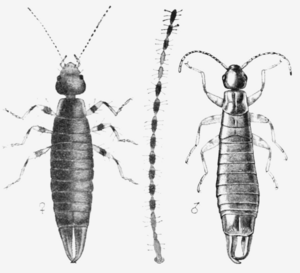Ringlegged earwig facts for kids
The ringlegged earwig (Euborellia annulipes) is a type of earwig that belongs to the Anisolabididae family. These insects are known for their unique appearance, especially the dark bands on their legs, which gives them their name.
Quick facts for kids Ringlegged earwig |
|
|---|---|
 |
|
| Scientific classification | |
| Kingdom: | |
| Phylum: | |
| Class: | |
| Order: | |
| Suborder: |
Forficulina
|
| Family: |
Anisolabididae
|
| Subfamily: |
Anisolabidinae
|
| Genus: |
Euborellia
|
| Species: |
E. annulipes
|
| Binomial name | |
| Euborellia annulipes (H. Lucas, 1847)
|
|
Contents
What Does a Ringlegged Earwig Look Like?
Adult ringlegged earwigs are usually dark brown. They can be about 10 to 25 millimeters (0.4 to 1 inch) long. These earwigs do not have wings. Just like many other earwig species, the female earwigs are usually bigger than the males.
Their legs are a light brown color. You can easily spot a dark band around the middle of their upper leg part, called the femur. Sometimes, this band is on the lower leg part, called the tibia. This is why they are called "ringlegged." Their antennae typically have sixteen parts, but this number can sometimes vary.
Differences Between Male and Female Earwigs
The ringlegged earwig has special pincers at its rear end, called cerci. In males, these pincers are more curved than in females. You can also tell the difference by looking at their abdomen (the main body section). Males have ten segments on their abdomen, while females only have eight.
Where Do Ringlegged Earwigs Live?
The ringlegged earwig was first described by a scientist named Hippolyte Lucas in 1847. It has been found in the United States since 1902. Over time, this species has spread all over the world. You can find them in many places, including Canada, Central and South America, Europe, India, China, and Japan.
These earwigs, like other types of earwigs, prefer to live in both warm, tropical places and milder, temperate climates.
Life Cycle of the Ringlegged Earwig
Female ringlegged earwigs usually lay their eggs in groups. Each group can have about fifty eggs. A female can lay two to four groups of eggs during her life.
The time of year when eggs are laid affects how long they take to hatch. If eggs are laid in the fall, they will usually stay in their incubation period over the winter. Eggs laid in the spring will hatch much faster. During this time, the mother earwig stays with her eggs. She protects them from animals that might want to eat them. She also eats any fungi that starts to grow on the eggs to keep them healthy.
From Nymph to Adult Earwig
A few days after hatching, the young earwigs, called nymphs, leave their nest. They look a lot like adult earwigs but are much smaller. They also do not have wings yet. While adult earwigs have different numbers of abdominal segments depending on their sex, nymphs always have ten segments.
Nymphs go through five stages of growth, called instars. This development usually takes between 45 and 176 days until they become full-grown adults. Interestingly, about 75% of these nymphs will grow up to be female earwigs.
Reproduction and Generations
Once they become adults, the earwigs will mate. About eleven days after mating, the female will lay her eggs. Ringlegged earwigs usually have two to three generations born each year. This means new groups of earwigs are born multiple times. For example, there might be one generation in the spring and another in the autumn. A single generation can complete its entire life cycle in about 61 days.
You can find adult ringlegged earwigs throughout the year, except during winter. In colder months, they stay hidden underground to survive.
See also
 In Spanish: Euborellia annulipes para niños
In Spanish: Euborellia annulipes para niños


